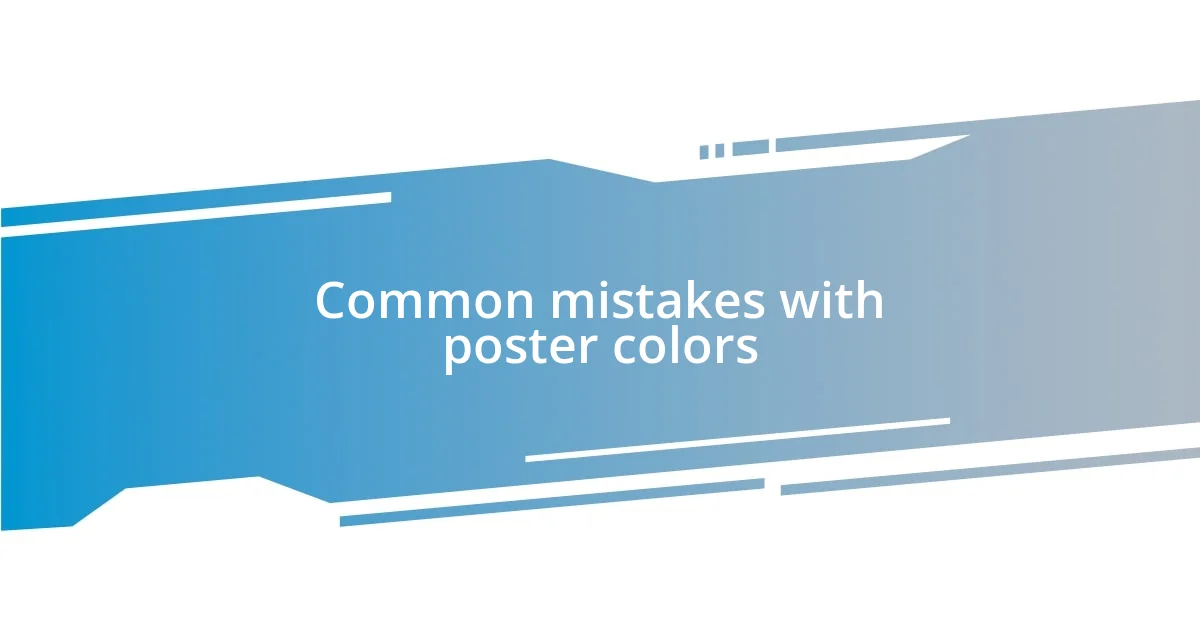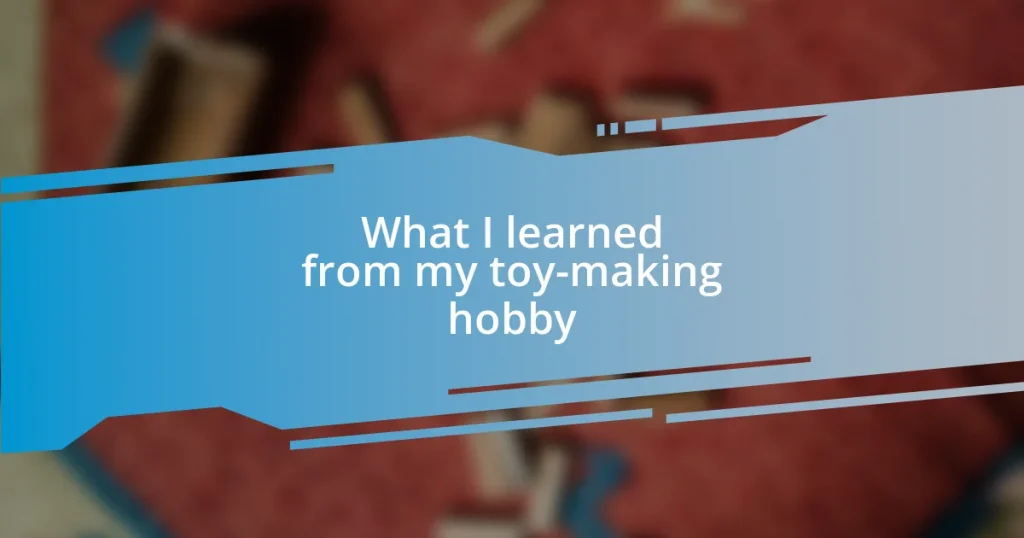Key takeaways:
- Poster colors are versatile, available in opaque and transparent types, and can create different effects based on application techniques.
- Choosing the right colors involves understanding their emotional impact, ensuring color harmony, and considering the audience.
- Caring for poster color materials, including proper storage and cleaning of tools, is essential for maintaining their quality and usability.

Understanding poster colors
Poster colors are a fascinating medium, blending the vibrancy of traditional paints with the ease of water colors. I remember my first experience with them; the way the pigments seemed to leap off the page enthralled me. Have you ever mixed a poster color and marveled at how it shifts from dull to brilliant with just a dash of water?
What strikes me about poster colors is their versatility. They can be applied thickly for a bold look or diluted for a softer, more ethereal effect. When I was experimenting with layering, I truly appreciated how different colors interacted; the way a deep blue and a bright yellow merged to create such a lively green made me rethink my approach to color dynamics.
The texture of poster colors is also something to consider. Unlike acrylics or oils, they dry quickly and can create a matte finish. I once tried to add a glossy varnish on top of my work, only to realize that the matte look of poster colors captured a charming rustic feel that I had grown to love. Isn’t it interesting how a simple decision can dramatically shift the outcome of your artwork?

Types of poster colors
Poster colors can generally be classified into two distinct types: opaque and transparent. Opaque poster colors, as the name suggests, are highly pigmented and provide excellent coverage, making them perfect for bold statements in artwork. I remember using opaque colors when I created a vibrant poster for a school project; it amazed me how one layer could completely cover the background. On the other hand, transparent poster colors are more fluid and allow for layering effects, which is something I’ve often enjoyed when painting landscapes, giving depth and dimension to my work.
An intriguing aspect of poster colors is how they can be water-soluble, making cleanup a breeze—something I especially appreciated during my art classes. Just a splash of water can transform these colors, enhancing their vibrancy and managing their texture. I once had a moment of revelation when I was working on a mixed media piece; using water to create soft gradients with the transparent colors opened my eyes to new possibilities in my art.
Now let’s take a look at the comparison of different types of poster colors in the table below. This can help illustrate their characteristics and uses effectively.
| Type | Characteristics |
|---|---|
| Opaque | High coverage, bold colors, ideal for strong statements |
| Transparent | Fluid, allows for layering, enhances depth |

How to choose poster colors
Selecting the right colors for your poster can be quite an exhilarating yet daunting task. I remember standing in front of my color palette, grappling between bold and subtle tones, wondering how each choice would impact the overall message of my artwork. It’s essential to consider the emotion and meaning behind the colors you choose—each hue stirs specific feelings. For instance, warm colors like red and orange evoke energy and passion, while cool colors like blue and green convey calmness and serenity.
When choosing poster colors, keep the following aspects in mind:
- Theme and Purpose: Determine the message you want to convey. Bright colors can grab attention, while pastel colors can depict tranquility.
- Color Harmony: Utilize the color wheel to find complementary or analogous colors that connect well together. Mixing a warm and cool color can create a dynamic contrast.
- Audience: Think about who will be viewing your poster. Kids might respond well to vibrant colors, while adults may prefer muted tones.
- Testing: Always try your colors on a scrap piece of paper to see how they look once dried. Each color can change slightly, which can be surprising.
With a thoughtful approach, choosing colors can turn into a satisfying journey of expression rather than just a decision-making task.

Techniques for using poster colors
Using poster colors effectively can significantly enhance your artwork, and there are several techniques I’ve embraced over the years. One method that’s been a game-changer for me is the wet-on-wet technique. By applying wet colors onto an already wet surface, I’ve discovered how beautifully the hues blend together—creating soft transitions that can make even the simplest composition look stunning. Have you ever watched colors dance into one another? It’s like a little magic show right on your canvas!
Layering is another exciting technique I often use. While opaque colors can stand alone powerfully, I’ve found that building them up through multiple layers allows me to achieve richness that can’t be matched with a single application. I recall a project where I meticulously layered different shades of blue. The result was a mesmerizing ocean effect that made me feel like I was staring into an actual sea. It’s vital, however, to let each layer dry before adding the next; patience really pays off in this case.
Lastly, don’t underestimate the power of texture. Mixing mediums, like sand or salt, with poster colors can elevate your artwork in unexpected ways. I remember experimenting with this during a community art event, and the textures added a whole new dimension to my pieces. Have you tried exploring textures in your artwork? It’s inspiring how something as simple as adding a gritty element can invite viewers to interact with your art on a deeper level. Stick with what resonates with you, and let your creativity guide the way!

Tips for mixing poster colors
Mixing poster colors can feel like a delightful puzzle. I remember the first time I tried creating a unique shade by blending red and yellow. I was thrilled to discover that the resulting orange was not just a mix, but something entirely personal. My tip? Start with small amounts of each color and gradually adjust until you find the hue that speaks to you. It’s almost like crafting a secret recipe that feels uniquely yours.
Have you ever struggled to get the right shade and ended up with a muddy mix instead? I’ve been there! One crucial tip I’ve learned is to keep your mixing palette clean. Any leftover paint can distort your new color. Experimenting with primary colors is great, but be mindful of how much you’re combining. I found that even mixing little bits at a time can yield surprising results—sometimes you only need a hint of blue to create a captivating teal.
In my experience, it’s also helpful to visualize where each color will be placed in your design before mixing. I recall a project where I was torn between a sunshine yellow and a deep gold. Once I imagined them side by side, the right mix became clear. This mental visualization keeps me grounded in my chosen palette. So, before you mix, take a moment to picture how those colors will dance together on your poster – you might just find that perfect blend you’ve been searching for!

Common mistakes with poster colors
It’s so easy to make mistakes when working with poster colors, especially if you rush the process. I remember trying to layer wet paint on top of wet paint without realizing it would lead to a muddy mess. The excitement of blending colors can be contagious, but I learned the hard way that patience is key. Have you ever found yourself in a similar situation, wishing you had just let one layer dry before diving into the next?
Another common pitfall is overmixing colors. I used to think that the more I mixed, the better the shade would turn out. Instead, I often ended up with a color that was far from what I envisioned. It took some time for me to appreciate the beauty of each color’s individuality. Have you experienced that moment of joy when a simple primary color retains its vibrancy?
Lastly, I’ve seen many artists, including myself at the start, overlooking the importance of using the right paper. The type of surface can dramatically affect how colors appear. I once used a rough-textured paper that absorbed all the pigment, resulting in a washed-out look. Have you ever had a project that didn’t go as planned simply because of the medium? It’s a reminder to choose carefully and ensure your materials align with your artistic vision.

Caring for poster color materials
Caring for my poster color materials has been a game changer for my art projects. I remember the first time I closed a tube of paint without properly sealing it. Within days, I found a hard, unusable lump instead of the vibrant hues I remembered. Did you know that a simple twist of the cap can preserve your colors for much longer? It’s an easy habit to develop that can save your art supplies and your wallet.
One essential aspect of maintaining poster colors is proper storage. I’ve learned that keeping my paints in a cool, dry place away from direct sunlight is critical. When I left a few paints out in the open, they dried up so quickly that I felt a real pang of frustration. Have you ever had that sinking feeling when you see your once-useful colors turn into a dried-out disappointment?
Another tip I find invaluable is cleaning my brushes thoroughly after each session. I’ll never forget the time I didn’t clean my favorite brush after using intense pigments, only to find bristles stuck together like glue later. It’s disappointing to see your tools fall short because of neglect. Ensuring they’re spotless and reshaping them helps maintain their longevity, keeping them ready for my next creative adventure. How do you care for your brushes? Every little step counts toward creating a smoother painting experience!
















